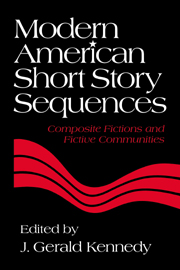Book contents
- Frontmatter
- Contents
- Contributors
- Introduction: The American Short Story Sequence – Definitions and Implications
- Henry James's Incipient Poetics of the Short Story Sequence: The Finer Grain (1910)
- Toomer's Cane as Narrative Sequence
- Hemingway's In Our Time: The Biography of a Book
- Wright Writing Reading: Narrative Strategies in Uncle Tom's Children
- The African-American Voice in Faulkner's Go Down, Moses
- Meditations on Nonpresence: Re-visioning the Short Story in Eudora Welty's The Wide Net
- Nine Stories: J. D. Salinger's Linked Mysteries
- Cheever's Shady Hill: A Suburban Sequence
- John Updike's Olinger Stories: New Light Among the Shadows
- Louise Erdrich's Love Medicine: Narrative Communities and the Short Story Sequence
- From Anderson's Winesburg to Carver's Cathedral: The Short Story Sequence and the Semblance of Community
- Index
Meditations on Nonpresence: Re-visioning the Short Story in Eudora Welty's The Wide Net
Published online by Cambridge University Press: 29 September 2009
- Frontmatter
- Contents
- Contributors
- Introduction: The American Short Story Sequence – Definitions and Implications
- Henry James's Incipient Poetics of the Short Story Sequence: The Finer Grain (1910)
- Toomer's Cane as Narrative Sequence
- Hemingway's In Our Time: The Biography of a Book
- Wright Writing Reading: Narrative Strategies in Uncle Tom's Children
- The African-American Voice in Faulkner's Go Down, Moses
- Meditations on Nonpresence: Re-visioning the Short Story in Eudora Welty's The Wide Net
- Nine Stories: J. D. Salinger's Linked Mysteries
- Cheever's Shady Hill: A Suburban Sequence
- John Updike's Olinger Stories: New Light Among the Shadows
- Louise Erdrich's Love Medicine: Narrative Communities and the Short Story Sequence
- From Anderson's Winesburg to Carver's Cathedral: The Short Story Sequence and the Semblance of Community
- Index
Summary
A good many critics have noted that Eudora Welty's elusive short stories strain toward moments of revelation and discovery, what Welty herself calls the “still moment” in the short story of that title in The Wide Net. It is fiction, Michael Kreyling argues, marked by the desire “for some resolution in but also beyond the plot,” a resolution that illuminates the underlying unity of the dreamlike fragments characterizing so many of her stories. Nowhere, in fact, would this affinity for the “still moment” seem to be more pronounced than in The Wide Net, Welty's second collection of stories, which might more accurately be called a sequence of stories, nearly all of which resonate with brief flashes of illumination and awakening.
In this respect, Welty, who quite often eludes the attempts of her critics to categorize and classify her, appears to ally herself with modernist writers who revere the Word for its capacity to transform and re-create a disorderly and fragmentary world. Historians of the short story, in fact, have argued that such a “still moment,” or epiphany, if you will, serves as the central distinguishing mark of the modernist short story in particular. Yet it is in The Wide Net, published in 1943, that Welty submits the notion of illumination to the sort of radical questioning that contemporary feminist critics and deconstructionists would readily recognize and appreciate, and does so in a form – the short story sequence – that both offers and withdraws the possibility of unity.
- Type
- Chapter
- Information
- Modern American Short Story SequencesComposite Fictions and Fictive Communities, pp. 98 - 113Publisher: Cambridge University PressPrint publication year: 1995



